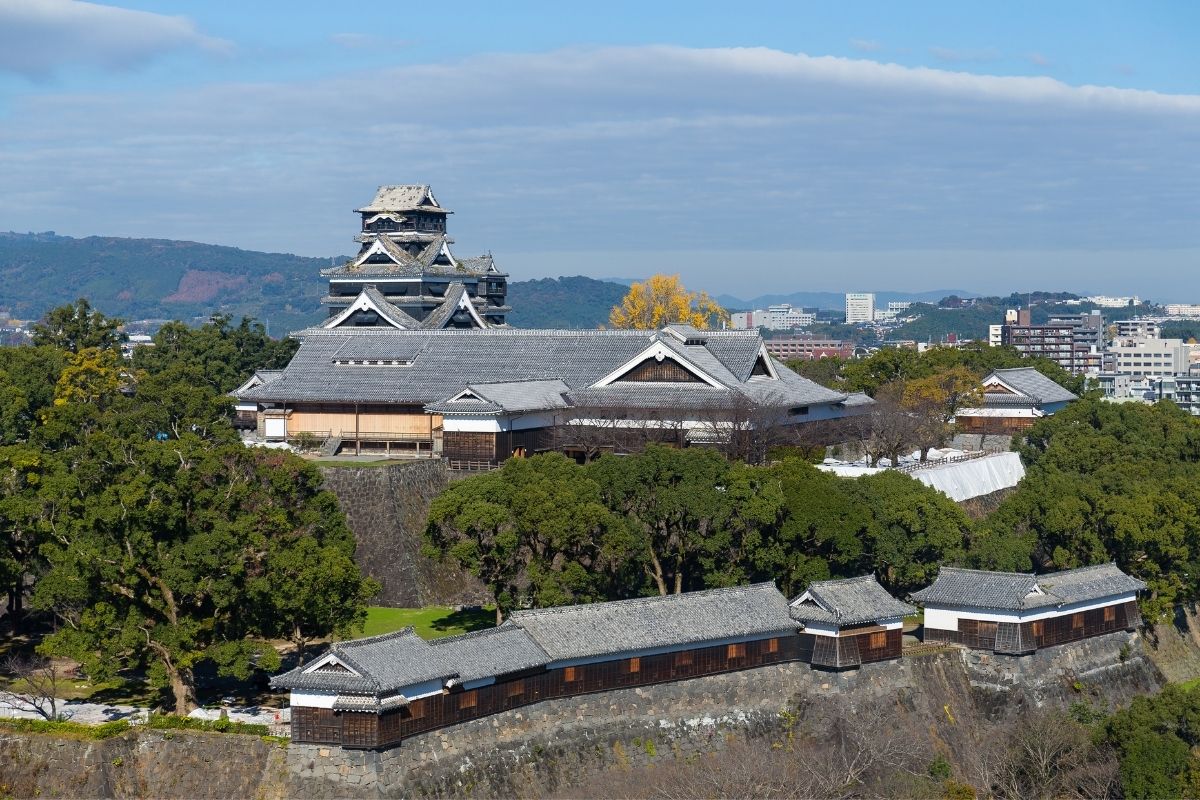Kumamoto Castle is a historical landmark located in downtown Kumamoto city, in Kyushu, Japan. It is considered one of the three premier castles in the country and is a popular tourist destination. The castle was originally built in 1607 by Kato Kiyomasa and has since undergone several reconstructions and renovations.
Despite being damaged during the Satsuma Rebellion in 1877, the castle has been well preserved and remains an impressive sight to behold. The castle grounds span over 49 hectares and include several buildings, including the castle keep (tenshukaku), which is a concrete reconstruction built in 1960. Visitors to Kumamoto Castle can explore the castle grounds and learn about the castle’s history and significance in Japanese culture.
Kumamoto Castle is not only a symbol of Japanese history and culture but also a testament to the resilience of the Japanese people. Despite facing several challenges and setbacks over the years, the castle has stood the test of time and continues to be a source of pride for the people of Kumamoto Prefecture. Whether you are a history buff or simply looking for a unique cultural experience, Kumamoto Castle is definitely worth a visit.
History
Kumamoto Castle is a historical landmark located in Kumamoto city, Japan. The castle’s history dates back to 1467 when fortifications were established by Ideta Hidenobu. The castle was then expanded in 1496 by Kanokogi Chikakazu, a local feudal lord. However, the iconic Kumamoto Castle that we see today was completed in 1607 by Kato Kiyomasa, the first daimyo (feudal lord) of the castle.
The construction of the castle took seven years, and upon its completion, the original castle consisted of 49 turrets, 18 turret gates, and several smaller buildings. The castle was designed to be a formidable fortress, and its walls were built to withstand enemy attacks.
Despite its impressive construction, the castle faced several challenges throughout history. During the Satsuma Rebellion in 1877, the castle was besieged by the Imperial Japanese Army. The castle’s defenders, led by the famous samurai Saigo Takamori, fought bravely but were eventually defeated. The castle was heavily damaged during the battle, and many of its buildings were destroyed.
After the battle, the castle was partially restored and opened to the public as a museum. Today, you can explore the castle’s various buildings and learn about its rich history. The castle is also a popular spot for cherry blossom viewing during the spring season.
Architecture
Kumamoto Castle is a hilltop Japanese castle located in Chūō-ku, Kumamoto, in Kumamoto Prefecture. It was constructed over seven years from 1601 to 1607, and upon its completion, the original castle consisted of 49 turrets, 18 turret gates, and 29 castle gates. The castle’s design is characterized by its jidorihafu plover gable windows found on all four sides of the main tower, ortenshukaku. The castle’s architecture is a fusion of traditional Japanese and modern Western styles.
The castle’s main tower is a five-story building with a basement and a rooftop observation deck. The tower’s exterior is covered with white plaster and decorated with black lacquer. The interior of the tower features a central pillar that supports the roof and four floors. Each floor of the tower has a different theme and displays various artifacts and exhibits related to the castle’s history and culture.
The castle’s walls are made of large stones and are up to 30 meters high in some places. The walls are designed to withstand earthquakes and other natural disasters. The castle’s moat is also an important feature of its architecture. The moat is fed by a nearby river and is up to 50 meters wide in some places. The moat and the castle’s walls are connected by stone bridges that add to the castle’s aesthetic appeal.
The castle underwent a major reconstruction project after it was severely damaged by the Kumamoto Earthquake in April 2016. The reconstruction project, which began in 2019 and is expected to take about 20 years to complete, aims to restore the castle to its original design while incorporating modern building techniques and materials. The reconstruction project also includes the construction of a new observation path that lets you view the castle’s reconstruction process up close.
Visiting Kumamoto Castle
Kumamoto Castle is a must-visit attraction for anyone traveling to Kumamoto. With its rich history and stunning architecture, the castle lets you unique glimpse into Japan’s feudal past. Here’s what you need to know before planning your visit:
Getting There: Kumamoto Castle is located in the heart of Kumamoto City, making it easily accessible by public transportation. The closest train station is Kumamoto Station, which is served by the JR Kyushu Shinkansen and several local train lines. From there, you can take a tram or bus to the castle grounds.
Admission: The admission fee for Kumamoto Castle is 800 yen for adults and 400 yen for children. If you plan on visiting other attractions in the area, consider purchasing a combination ticket to save money.
What to See: Kumamoto Castle is known for its impressive stone walls and towering turrets, which offer stunning views of the city. Visitors can also explore the castle’s interior, which features exhibits on the castle’s history and architecture. Be sure to check out the reconstructed Honmaru Palace, which was destroyed in a fire in 1877 and recently reopened to the public.
When to Go: The best time to visit Kumamoto Castle is during the spring cherry blossom season or the fall foliage season. However, be prepared for crowds during these peak times. If you prefer a quieter experience, consider visiting on a weekday or during the winter months.
Tips: Wear comfortable shoes, as there is a lot of walking involved. Bring a hat and sunscreen during the summer months, as the castle grounds can get hot and sunny. And don’t forget to bring your camera to capture the stunning views!
Famous Events at Kumamoto Castle
Kumamoto Castle is a historic site that has witnessed many significant events throughout its history. Here are some of the famous events that took place at Kumamoto Castle:
Battle of Kumamoto Castle
During the Seinan War in 1877, Kumamoto Castle was the site of a fierce battle between the Imperial Japanese Army and the rebel forces led by Saigo Takamori. The castle was heavily damaged during the battle, and many of its structures were destroyed. The Imperial Army eventually emerged victorious, and Saigo Takamori committed suicide shortly after the battle.
Castle Restoration
After the battle, the castle went through a period of restoration. The restoration work was carried out over a period of ten years, and the castle was finally reopened to the public in 1960. Today, you can see the restored castle and learn about its history at the Kumamoto Castle Museum.
Cherry Blossom Festival
Every spring, Kumamoto Castle hosts a cherry blossom festival that attracts thousands of visitors from all over Japan. The festival is held in early April, when the cherry blossoms are in full bloom. Visitors can enjoy the beautiful scenery of the castle grounds and participate in various activities, such as tea ceremonies, traditional music performances, and food stalls.
Fireworks Display
Another popular event at Kumamoto Castle is the fireworks display that takes place every summer. The display is usually held in late July or early August and features a spectacular show of fireworks set against the backdrop of the castle. Visitors can watch the fireworks from various locations around the castle, including the castle tower and the castle grounds.
The Sum Up
Kumamoto Castle should be on your to-do-list for anyone interested in Japanese history and architecture. The castle has a rich and fascinating history, having survived wars, earthquakes, and fires. Visitors can explore the castle grounds and admire the impressive stone walls, turrets, and gates that have stood the test of time.
Despite the damage caused by the 2016 Kumamoto earthquake, the castle is undergoing extensive restoration work to ensure its preservation for future generations. The restoration project is expected to be completed in 2021, and visitors will be able to see the castle in its full glory once again.
One of the highlights of Kumamoto Castle is the reconstructed castle keep, which offers panoramic views of the city and surrounding countryside. Visitors can also explore the various buildings and structures on the castle grounds, including the Ninomaru Palace, the Kato Shrine, and the Hana-no-Gosho Palace.
Overall, Kumamoto Castle is a testament to the ingenuity and resourcefulness of the Japanese people, who have managed to preserve and restore this historic landmark despite the challenges it has faced over the centuries. Whether you’re a history buff or simply looking for a unique cultural experience, Kumamoto Castle is well worth a visit.




